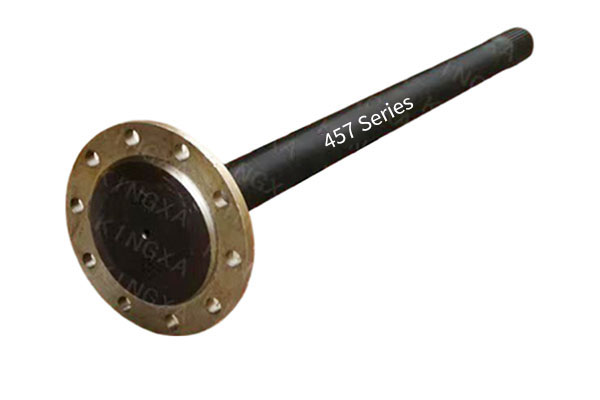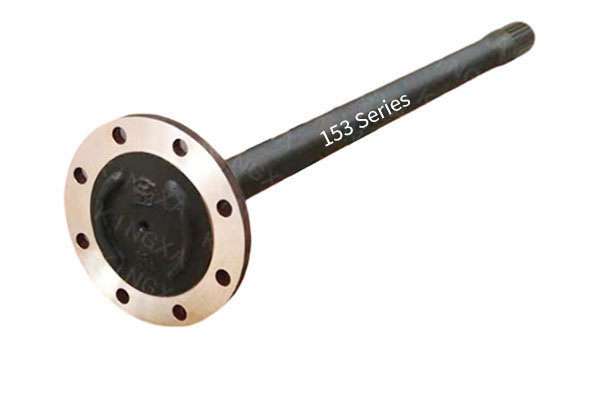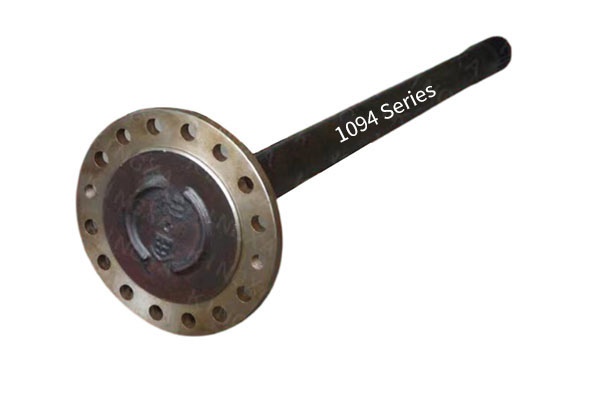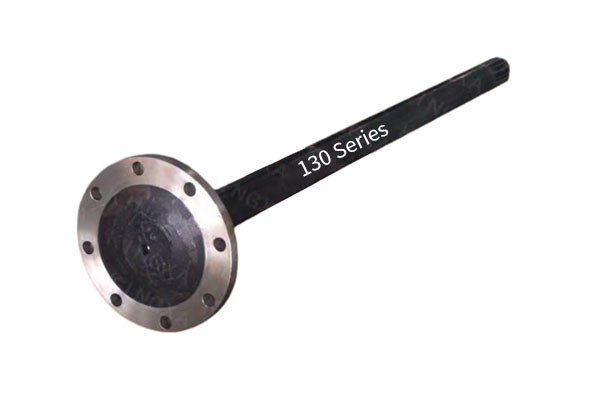How to improve the strength and durability of heavy-duty vehicle rear axle half shaft through optimized design?
Release Time : 2025-07-07
As a key component of the power transmission system, the strength and durability of the heavy-duty vehicle rear axle half shaft are directly related to the safe operation and service life of the vehicle. In order to meet the increasingly stringent working environment requirements, optimized design has become an important way to improve the performance of the half shaft. Through comprehensive consideration of material selection, structural design and manufacturing process, the strength and durability of the half shaft can be significantly enhanced.
In terms of material selection, the use of high-strength alloy steel is one of the effective means to improve the strength of the heavy-duty vehicle rear axle half shaft. This type of steel not only has excellent mechanical properties, but also can maintain good toughness while bearing high loads, effectively preventing fatigue fracture. In addition, the application of new composite materials also provides more possibilities for the design of the half shaft. These materials combine the advantages of metals and non-metals, reduce weight without sacrificing strength, and help improve the overall fuel economy and operational flexibility of the vehicle.
In terms of structural design, the rational layout of stress concentration areas is the focus of optimized design. For example, in the key parts of the half shaft, such as the spline part, the gradual transition design is adopted instead of the sudden change structure, which can evenly distribute the stress and reduce the risk of local overload. At the same time, adding appropriate reinforcement ribs or changing the cross-sectional shape is also a common design strategy. This can not only improve the overall stiffness, but also guide the stress flow to a direction that is more conducive to dispersion, thereby reducing the probability of failure. For the design of the connecting flange, special attention should be paid to the matching accuracy between it and the wheel hub to ensure that there is no slip when transmitting large torque, and to ensure the stability and reliability of power transmission.
Advanced manufacturing processes are also crucial to improving the strength and durability of the half shaft. Precision forging technology can improve the organizational structure of the material at the microscopic level, eliminate internal defects, and improve the surface quality. The heat treatment process further enhances the hardness and wear resistance of the steel, so that the half shaft still performs well in the face of complex road conditions. At the same time, strict inspection processes are carried out throughout the entire production cycle, including non-destructive testing, hardness testing, etc., to ensure that each finished product meets high standards of quality requirements.
The optimization of the lubrication system cannot be ignored. High-quality lubricating oil film can form an effective protective barrier between moving parts, reduce friction and wear, and help dissipate heat and cool down. According to the needs of different working environments, the selection of appropriate lubricant types and addition amounts can significantly extend the service life of the half shaft. Especially for heavy-duty vehicles working under high temperature and high pressure conditions, good lubrication conditions are the basis for ensuring their long-term stable operation.
To adapt to extreme climatic conditions, designers also need to consider how to enhance the corrosion resistance of the half shaft through surface treatment. For example, electroplating, phosphating or spraying anti-corrosion coatings can effectively isolate moisture and oxygen in the air and prevent metal oxidation and rust. This is especially important for heavy-duty vehicles that are often exposed to bad weather. It can not only extend the service life of parts, but also reduce maintenance costs and frequency.
Finally, considering the convenience of maintenance in actual applications, the optimized design also needs to take into account the characteristics of easy disassembly and replacement. The modular design concept enables maintenance personnel to complete the inspection and replacement of the half shaft in a short time, reducing downtime and improving operational efficiency. This people-oriented design concept not only improves the user-friendliness of the product, but also saves a lot of time and resources for the company.
In summary, the strength and durability of heavy-duty vehicle rear axle half shaft can be significantly improved by optimizing multiple dimensions, including material selection, structural design, manufacturing process, and surface treatment. Every detail improvement is to better cope with complex use environments and ensure that the vehicle can operate safely and reliably under various working conditions. With the continuous advancement of technology, we have reason to believe that more advanced and efficient half-shaft design solutions will emerge in the future, bringing more surprises and possibilities to the transportation industry.
In terms of material selection, the use of high-strength alloy steel is one of the effective means to improve the strength of the heavy-duty vehicle rear axle half shaft. This type of steel not only has excellent mechanical properties, but also can maintain good toughness while bearing high loads, effectively preventing fatigue fracture. In addition, the application of new composite materials also provides more possibilities for the design of the half shaft. These materials combine the advantages of metals and non-metals, reduce weight without sacrificing strength, and help improve the overall fuel economy and operational flexibility of the vehicle.
In terms of structural design, the rational layout of stress concentration areas is the focus of optimized design. For example, in the key parts of the half shaft, such as the spline part, the gradual transition design is adopted instead of the sudden change structure, which can evenly distribute the stress and reduce the risk of local overload. At the same time, adding appropriate reinforcement ribs or changing the cross-sectional shape is also a common design strategy. This can not only improve the overall stiffness, but also guide the stress flow to a direction that is more conducive to dispersion, thereby reducing the probability of failure. For the design of the connecting flange, special attention should be paid to the matching accuracy between it and the wheel hub to ensure that there is no slip when transmitting large torque, and to ensure the stability and reliability of power transmission.
Advanced manufacturing processes are also crucial to improving the strength and durability of the half shaft. Precision forging technology can improve the organizational structure of the material at the microscopic level, eliminate internal defects, and improve the surface quality. The heat treatment process further enhances the hardness and wear resistance of the steel, so that the half shaft still performs well in the face of complex road conditions. At the same time, strict inspection processes are carried out throughout the entire production cycle, including non-destructive testing, hardness testing, etc., to ensure that each finished product meets high standards of quality requirements.
The optimization of the lubrication system cannot be ignored. High-quality lubricating oil film can form an effective protective barrier between moving parts, reduce friction and wear, and help dissipate heat and cool down. According to the needs of different working environments, the selection of appropriate lubricant types and addition amounts can significantly extend the service life of the half shaft. Especially for heavy-duty vehicles working under high temperature and high pressure conditions, good lubrication conditions are the basis for ensuring their long-term stable operation.
To adapt to extreme climatic conditions, designers also need to consider how to enhance the corrosion resistance of the half shaft through surface treatment. For example, electroplating, phosphating or spraying anti-corrosion coatings can effectively isolate moisture and oxygen in the air and prevent metal oxidation and rust. This is especially important for heavy-duty vehicles that are often exposed to bad weather. It can not only extend the service life of parts, but also reduce maintenance costs and frequency.
Finally, considering the convenience of maintenance in actual applications, the optimized design also needs to take into account the characteristics of easy disassembly and replacement. The modular design concept enables maintenance personnel to complete the inspection and replacement of the half shaft in a short time, reducing downtime and improving operational efficiency. This people-oriented design concept not only improves the user-friendliness of the product, but also saves a lot of time and resources for the company.
In summary, the strength and durability of heavy-duty vehicle rear axle half shaft can be significantly improved by optimizing multiple dimensions, including material selection, structural design, manufacturing process, and surface treatment. Every detail improvement is to better cope with complex use environments and ensure that the vehicle can operate safely and reliably under various working conditions. With the continuous advancement of technology, we have reason to believe that more advanced and efficient half-shaft design solutions will emerge in the future, bringing more surprises and possibilities to the transportation industry.







